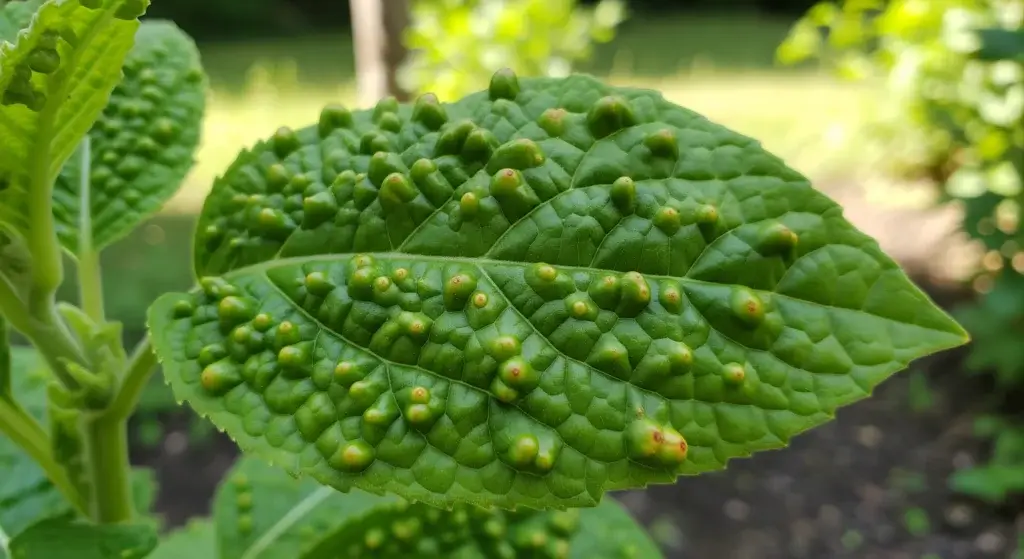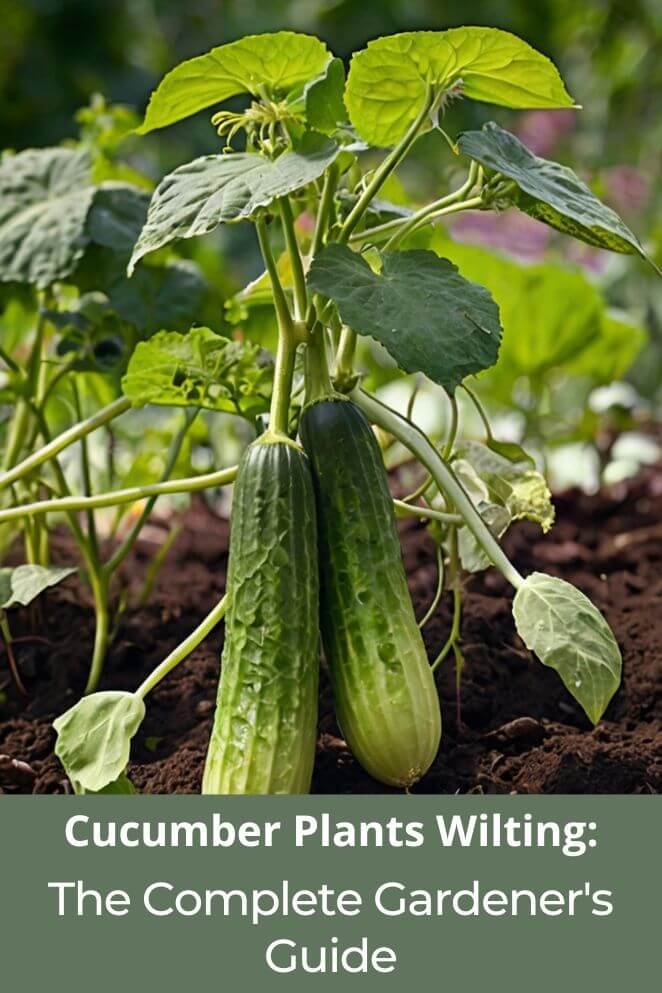
Uh-oh—your once-happy cucumber plants are suddenly wilting like they just heard their favorite show got canceled. Don’t panic!
This is super common, even for experienced gardeners.
Cucumbers grow fast and give great harvests, but they’re total divas when it comes to water, weather, and care.
Wilting leaves? That’s their dramatic way of saying, “Help me!”The good news? Most causes are easy to fix—and even easier to prevent once you know what’s going on.
Let’s break down the real reasons your cukes are throwing a fit, and how to get them back on track.
Understanding Why Cucumber Plants Wilt: The Science Behind the Symptoms
So here’s the deal: when your cucumber plants start flopping over like they just pulled an all-nighter binge-watching Netflix, it usually means they’re losing more water than they can take in.
Their cells basically deflate—kind of like a balloon with a slow leak.
That deflation is called turgor pressure loss (fancy plant-speak for “I’m thirsty and stressed!”).
Turgor pressure is what keeps leaves perky and upright.
When your plant can’t get enough water—whether it’s from dry soil, fried roots, or a nasty infection—it loses that pressure, and the leaves go limp like wet spaghetti.
The tricky part? Wilting can be caused by totally different things: overwatering, underwatering, heat waves, or even bacteria playing villain.
That’s why step one is figuring out the why—because watering more won’t help if the real issue is root rot or a sneaky wilt disease.
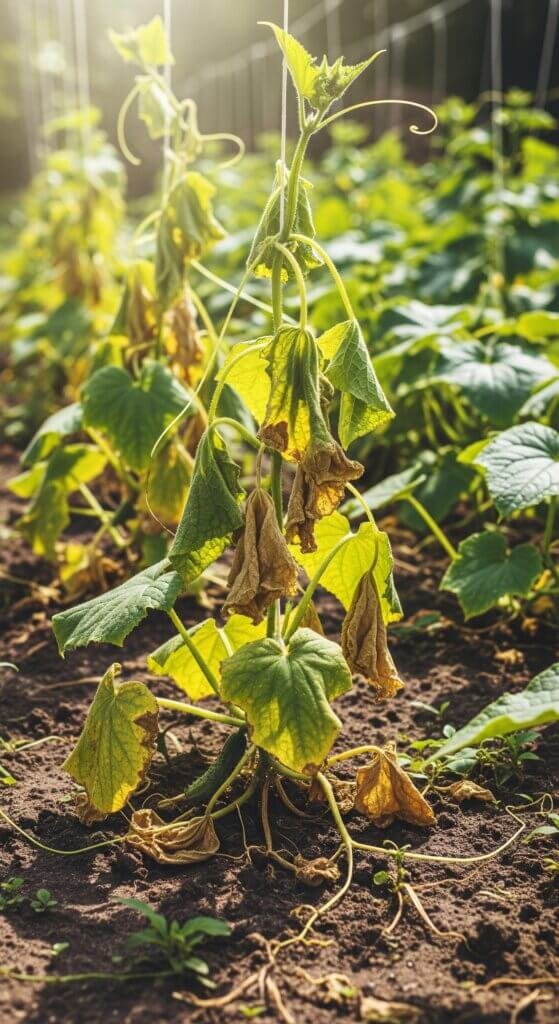
The Most Common Causes of Cucumber Plant Wilting
Let’s face it—wilted cucumbers are the ultimate gardening heartbreak.
One day they’re thriving, the next they’re flopping like overcooked noodles.
Here’s what’s usually going on behind the drama:
1. Watering issues
Cukes are thirsty—but not that thirsty. The most common cause of wilting? Bad watering habits.
Too little or too much water, and boom—your plant starts throwing a tantrum.
Underwatering signs:
- Soil is bone-dry a few inches down
- Leaves get crispy, like they’ve been sunbathing too long
- Plant looks extra sad midday, then perks up in the evening (classic drama queen move)
Overwatering signs:
- Soil feels soggy or swampy
- Leaves turn yellow and squishy
- Mushy base or fungus around the stem
- Wilting doesn’t improve even when it cools down
Fix it:
Water consistently—aim for about 1 inch per week. Think of it like keeping your plant hydrated on a long hike, not drowning it in a waterpark.
2. Bacterial wilt
If your cucumber looks fine one day and totally wilted the next (no yellowing, just straight-up collapse), you might be dealing with bacterial wilt—a.k.a. the cucumber’s version of a horror movie.
The real villain? The striped cucumber beetle.
It snacks on your plants and spreads bacteria like a gossip queen at brunch.
How to test for it:
Cut a wilting stem near the bottom and squeeze it. If goo comes out, touch it with a knife and slowly pull away.
If it forms a sticky thread like melted cheese—yep, it’s bacterial wilt.
How it spreads:
- Beetles munch infected plants
- Bacteria party in their gut
- Beetles bite healthy plants and deliver the bacteria
- The bacteria enter through wounds (usually beetle bites)
No cure once it hits, so focus on prevention: control cucumber beetles early and often.
3. Environmental stress factors
Cukes don’t like surprises. They love consistency, and any sudden change can send them into wilt-mode.
Common stressors:
- Heatwaves: Over 90°F? They start to melt.
- Cold snaps: Night temps drop fast? They get cranky.
- Transplant shock: You moved them outside too soon? Expect sulking.
- Soil trouble: Poor drainage = soggy roots = no bueno. Compacted soil? Roots can’t grow.
Pro tip: Harden off your seedlings before transplanting, and make sure your soil drains well and has good structure. Cukes like their feet moist, not muddy.
4. Pest-related wilting
Some bugs don’t nibble—they destroy.
Squash Vine Borers:
These little jerks burrow into the vine and eat it from the inside out.
Quick fix: Find the entry hole, stick in a wire, and skewer the grub like a kebab. Brutal but effective.
Root-Knot Nematodes:
- Tiny worms in the soil that mess up your plant’s roots.
- They cause wilting, stunted growth, and general plant sadness.
- More common in sandy, warm soil.
What to do:
Rotate crops, solarize soil if needed, and plant resistant varieties if nematodes are a known problem in your area.
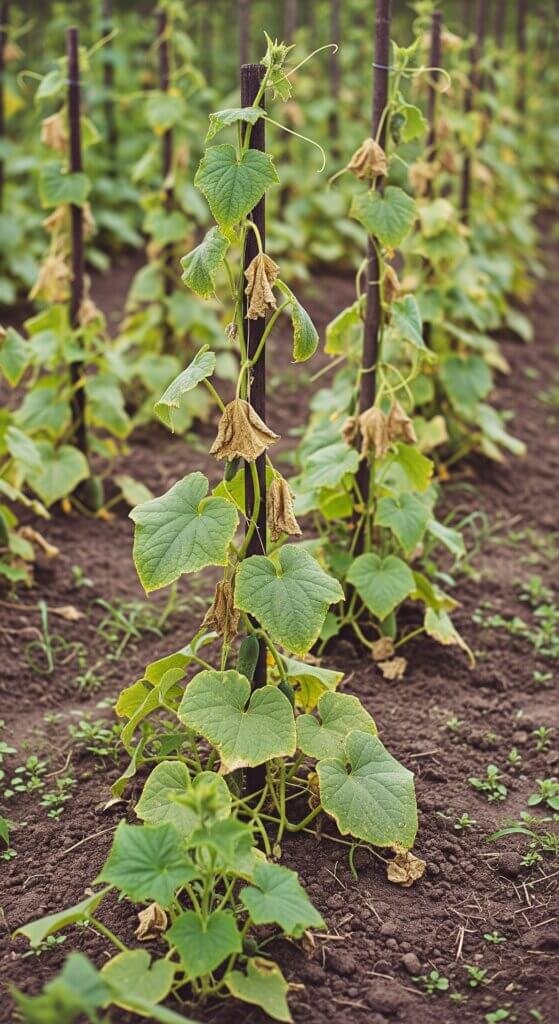
Prevention Strategies: Keeping Your Cucumber Plants Healthy
Want to avoid cucumber heartbreak? Focus on keeping your plants happy before they start drooping.
Here’s your plant-care cheat sheet—no fluff, just solid, down-to-earth advice.
Optimal watering techniques
Watering cucumbers is like making pasta—too little and it’s dry, too much and it’s mush.
Aim for 1/4 to 1/2 gallon per plant each time you water, but it’s the timing and method that really matter.
Watering Tips:
- Go deep, not daily. Water less often, but soak it—this trains roots to grow deep and strong.
- Water at the base, not the leaves. Think of it like keeping your laptop dry in the rain.
- Do it early—before 10 a.m.—so the leaves can dry out before bedtime (wet leaves at night = fungus party).
- Use drip irrigation or soaker hoses if you can. Your plants will thank you.
- Not sure if they need water? Stick your finger 2–3 inches in the soil. If it’s dry, it’s time to water. If not, hold off.
Soil preparation and management
Good cucumbers start with good soil. No drama queens grow in dead dirt.
Here’s what they like:
- Well-draining soil: No swampy roots, please. Soggy feet = sad plants.
- Lots of organic matter: Add 2 inches of compost or aged manure before planting. Cukes are hungry.
- pH around 6.5–7.0: Neutral-ish soil is the sweet spot.
- Loose, workable texture: Roots need space to spread out—think fluffy, not packed like concrete.
Integrated pest management
Cucumber beetles aren’t just annoying—they spread bacterial wilt like it’s gossip.
You don’t need to go full Breaking Bad with chemicals—just work smarter.
Physical barriers
- Use floating row covers early on. Basically a bug-proof hoodie for your plants.
- Beetle traps along the garden edge can help stop them before they get comfy.
- Remove covers once flowers show up so the pollinators can do their thing.
Beneficial insects
- Ladybugs, lacewings, and other bug bouncers eat beetles for breakfast.
- Grow flowers like dill, fennel, or alyssum to attract them.
- Avoid broad insect sprays that kill everything—including the good guys.
Smart growing habits
- Rotate your crops each season. Don’t plant cukes in the same spot every year.
- Clean up dead plants after harvest—no need to leave a beetle buffet behind.
- Keep your plants healthy and well-watered. Strong plants can handle a little bug drama without wilting.
Treatment and Recovery Methods
Your cucumber plant looks like it just ran a marathon in flip-flops—and now it’s wilting hard. Don’t panic.
With a little detective work and quick action, you can often turn things around.
Immediate response to wilting
When you see wilting, don’t just water and hope. Start with a mini inspection:
- Feel the soil—is it dry, soggy, or somewhere in between?
- Look under the leaves—any pests lurking?
- Check the stem—soft spots, ooze, or chew marks?
- Too hot outside? Throw on some emergency shade (old bedsheet, shade cloth, beach umbrella—go full MacGyver).
Now, based on what you find…
Treating water-related wilting
For underwatered plants:
- Water slowly and deeply so it soaks in—not just a splash on top.
- Add mulch around the base to lock in moisture (think cucumber spa day).
- Give them temporary shade for a day or two so they can recover.
- Keep checking daily—once perky leaves return, you’re back in business.
For overwatered plants:
- Hands off the watering can—give them a break.
- Improve drainage if you can (elevate pots, loosen soil, add compost).
- Cut off any mushy stems or rotted roots—don’t let that stuff fester.
- If root rot is setting in, hit it with an organic fungicide.
Managing bacterial wilt
This one’s tough. Once bacterial wilt hits, there’s no cure.
It spreads fast and doesn’t give second chances.
What to do:
- Do the string test: cut a wilted stem, touch the goo with a knife, and pull back—if it stretches like melted cheese, it’s bacterial wilt.
- Yank infected plants ASAP. No mercy.
- Bury or trash them—don’t compost or you’ll be re-wilting next year.
- Double down on cucumber beetle control—they’re the ones spreading the disease like bad rumors.
- For next season, look for resistant varieties and rotate where you plant cukes.
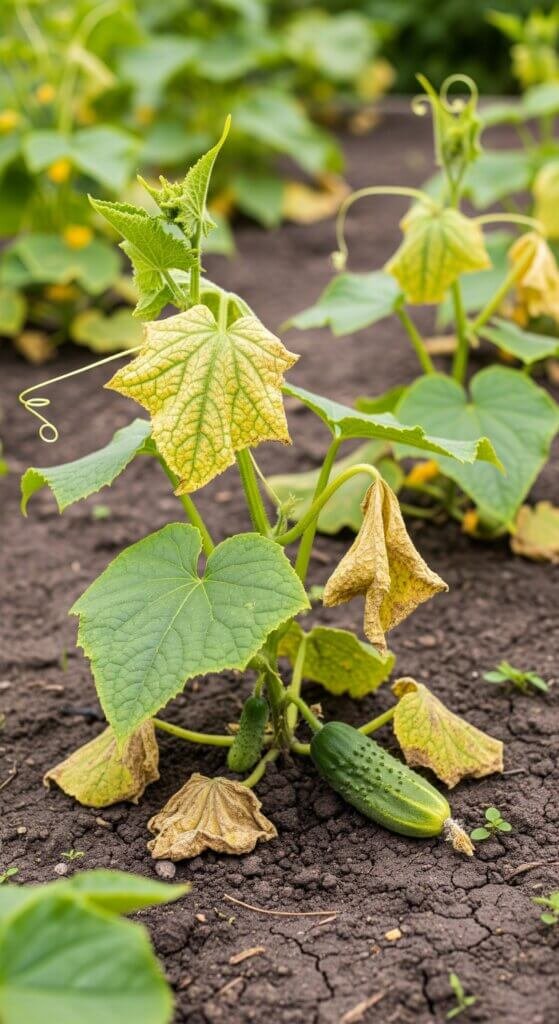
Advanced Prevention Techniques
You’ve mastered watering and basic pest patrol—now it’s time to go pro.
These next-level tips help you fight off pests, avoid disease drama, and keep your cucumber patch thriving all season.
Companion planting
Your cucumbers don’t grow in a vacuum—and who you plant next to them matters.
Some plant buddies help them thrive, others are basically the bad roommates of the garden.
Beneficial companions:
- Radishes – Think of them as cucumber bodyguards. They repel cucumber beetles without making a fuss.
- Nasturtiums – Pretty flowers that act like pest magnets (on purpose!). Aphids and beetles will go for them instead of your cukes.
- Marigolds – All-around pest deterrents with serious garden street cred.
- Beans – These fix nitrogen in the soil, which helps cucumbers grow faster and stronger. It’s like free fertilizer—thanks, beans!
Plants to avoid:
- Sage, mint, other strong herbs – They mess with cucumber flavor and growth. Keep them in their own herb garden.
- Melons, squash, pumpkins – They’re cucumber cousins, and they share diseases like a group chat gone wrong.
- Heavy feeders – Plants that hog nutrients (like corn or broccoli) will leave your cukes hangry.
Season extension and protection
Sometimes Mother Nature throws curveballs—early heatwaves, late cold snaps, or a surprise bug infestation.
That’s where these tools come in:
Row Covers and tunnels:
- Think of them like cucumber tents.
- They keep out beetles, soften the shock of outdoor life after transplanting, and help regulate temps when the weather’s all over the place.
- Use them early, then pull them off once your plants start flowering so the bees can do their thing.
Mulching benefits:
- Keeps soil moist and cozy (no wild swings from wet to dry).
- Smothers weeds, which often harbor pests.
- Helps regulate soil temperature, especially during heatwaves or chilly nights.
- Bonus: As it breaks down, it adds nutrients to the soil—free soil upgrade!
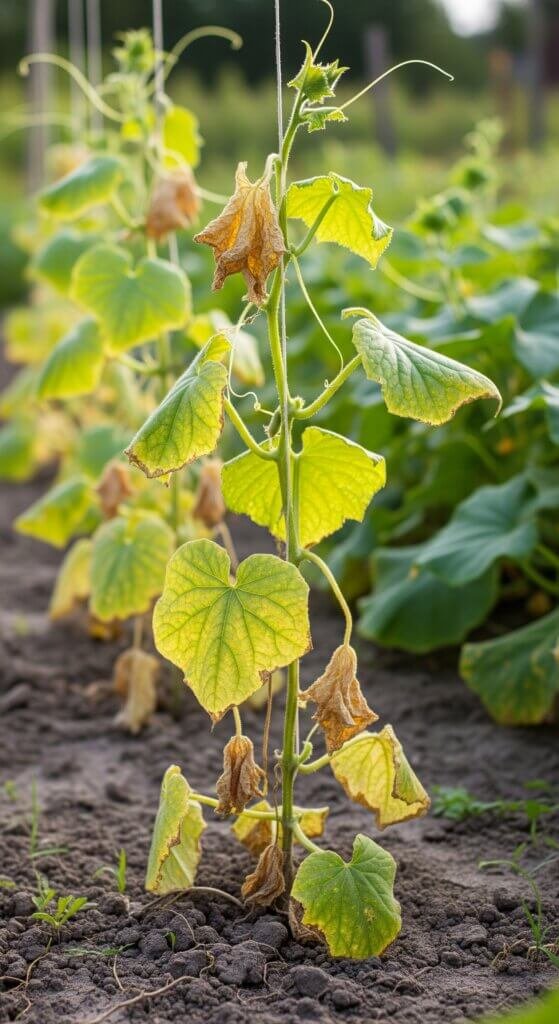
Troubleshooting Common Wilting Scenarios
Wilting cucumbers can feel like a gardening mystery. But once you know what to look for, it’s like reading plant body language.
Here’s a quick cheat sheet for the most common wilt drama—and what to do about it:
Scenario 1: Sudden wilting after transplanting
- Looks like: Fresh transplant suddenly wilts like it’s emotionally overwhelmed.
- Likely cause: Transplant shock (new digs = stress).
Quick fix:
- Give it some shade for a few days—nothing fancy, even an old T-shirt will do.
- Keep the soil evenly moist but not soggy.
- Skip the fertilizer until it perks back up—too much too soon = bad first date vibes.
Scenario 2: Gradual wilting with yellow leaves
- Looks like: Plant is drooping a little more each day, leaves turning yellow like they’re giving up.
- Likely cause: Overwatering or unhappy roots.
Quick fix:
- Cut back on watering. Seriously—your cucumbers aren’t fish.
- Check if the soil drains well. If not, time to fluff it up with compost or sand.
- Dig around the base—if roots are brown and mushy, you’ve got root rot. Remove affected parts and treat with fungicide if needed.
Scenario 3: Wilting during hot afternoons only
- Looks like: Perfectly healthy in the morning, total drama queen by afternoon heat.
- Likely cause: Heat stress or a little underwatering.
Quick fix:
- Water a bit more in the morning—don’t wait for the wilt.
- Mulch like a pro. It helps hold moisture and keeps roots cool.
- Toss some afternoon shade their way if the sun’s going full blast. Beach umbrella? Go for it.
Scenario 4: Wilting with beetle presence
- Looks like: Your plant is wilting and you spot striped cucumber beetles hanging around like troublemakers.
- Likely cause: Bacterial wilt (spread by those very beetles).
Quick fix:
- Do the string test—cut the stem and pull some sap. If it stretches like cheese, it’s bacterial wilt.
- Yank and bag the infected plant fast—don’t let it infect the others.
- Go full defense mode: row covers, traps, and keep an eye on those beetles like they’re stealing cookies from the jar.
Final Take: Don’t Let Wilting Kill Your Cucumber Vibe
Wilting cucumbers aren’t the end of the world—they’re just plants throwing a fit.
The good news? Now you know why they wilt and what to do about it.
Stay consistent: water smart, feed well, watch for pests, and act fast when something looks off.
Prevention always beats scrambling to fix a disaster. Think of it like plant parenting—less guessing, more noticing.
Every gardener deals with wilt at some point (it’s basically a rite of passage).
What matters is learning from it and leveling up each season.
Stick with the tips in this guide, and your cucumbers will go from drama queens to harvest heroes in no time.


